Rescuers are still assessing the scale of the Indonesian disaster. Many areas were cut off when roads buckled and phone towers went down. Aftershocks continue to rattle the area, raising fears of more tsunamis.
CGTN’s Barnaby Lo reports on the tens of thousands remaining in shelters, too fearful to go home.
Several towns have been cut off in the immediate aftermath of the earthquake and tsunami that hit Indonesia’s Central Sulawesi province last week. One of those areas was Donggala, a town not far from the epicenter of the earthquake.
A whole stretch of Donggala’s coastline was obliterated by last weekend’s earthquake and tsunami. However, CGTN has been to other parts of Donggala and many of them are relatively unaffected. The problem is that the earthquake and tsunami have inflicted a different kind of damage on residents.
“We are still traumatized because there are still earthquakes and we heard that there could be another big one,” one evacuee said.
Some residents go back to their houses during the day to bathe and change, but choose to stay in makeshift evacuation camps out of fear. Some are even running out of money and getting very little help.

Residents shelter at a park in Palu on October 2, 2018, four days after a strong earthquake and tsunami hit the area. (AFP PHOTO / BAY ISMOYO)
One evacuee CGTN interviewed was nine months pregnant when she fled. She gave birth two days after the disaster.
“I just ran without thinking. I even managed to carry my baby,” she said.
The more fortunate residents are fleeing elsewhere, where they have relatives and friends. However, even that is a challenge. Meanwhile, cars and motorcycles line up nearly half a kilometer just for fuel.
 CGTN America
CGTN America
 A young survivor cooks dinner in a field of a mosque where she took shelter with her family in Palu, Indonesia’s Central Sulawesi on October 1, 2018, after an earthquake and tsunami hit the area on September 28. (AFP PHOTO / Jewel SAMAD)
A young survivor cooks dinner in a field of a mosque where she took shelter with her family in Palu, Indonesia’s Central Sulawesi on October 1, 2018, after an earthquake and tsunami hit the area on September 28. (AFP PHOTO / Jewel SAMAD)
